The American Anti-Slavery Society was established in 1833, but
abolitionist sentiment antedated the republic. For example, the
charter of Georgia prohibited slavery, and many of its settlers
fought a losing battle against allowing it in the colony, Before
independence, Quakers, most black Christians, and other religious
groups argued that slavery was incompatible with Christ's
teaching. Moreover, a number of revolutionaries saw the glaring
contradiction between demanding freedom for themselves while
holding slaves. Although the economic center of slavery was in
the South, northerners also held slaves, as did African Americans
and Native Americans. Moreover, some southerners opposed
slavery. Blacks were in the vanguard of the anti-slavery
movement. Abolitionist literature began to appear about 1820.
Until the Civil War, the anti-slavery press produced a steadily
growing stream of newspapers, periodicals, sermons, children's
publications, speeches, abolitionist society reports, broadsides,
and memoirs of former slaves.
The Library of Congress has a wealth of material that
demonstrates the extent of public support for and opposition to
abolition. Broadsides advertise fairs and bazaars that women's
groups held to raise money for the cause. Other publications
advertise abolitionist rallies, some of which are pictured in
prints from contemporaneous periodicals. To build enthusiasm at
their meetings, anti-slavery organizations used songs, some of
which survive. The Library also has many political and satirical
prints from the 1830s through the 1850s that demonstrate the
rising sectional controversy during that time.
Although excellent studies of the abolition movement exist,
further research in the Library's manuscripts could document the
lesser known individuals who formed the movement's core. Other
promising topics include the roles of women and black
abolitionists and the activities of state and local abolitionist
societies.

Early Anti-Slavery Publication |
Jonathan Edwards, Jr., (1745-1801), was, like his more famous
father, a Congregationalist minister. He served at the White
Haven Church in New Haven, Connecticut, and later became
president of Union College in Schenectady, New York. In this
sermon, Edwards presented forceful arguments against ten common
pro-slavery positions. One of the earliest anti-slavery
publications in the Library of Congress collections, the sermon
demonstrates the existence of strong anti-slavery feeling in the
early days of the republic.
Injustices and Impolicy of the Slave Trade and of the Slavery of
Africans . . . , Title page
Jonathan Edwards [Jr.], Author
New Haven: Thomas & Samuel Green, 1791
Rare Book and Special Collections Division (35)
|
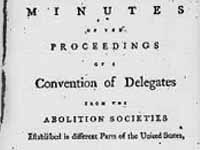
Minutes of Early Anti-Slavery Meeting |
On January 1, 1794, delegates from the abolition societies of
Connecticut, New York, New Jersey, Pennsylvania, Delaware, and
Maryland met in Philadelphia, a stronghold of the anti-slavery
Quaker religion. The group voted to petition Congress to
prohibit the slave trade and also to appeal to the legislatures
of the various states to abolish slavery. The petitions pointed
out the inconsistency of a country that had recently rejected the
tyranny of kings engaging in "domestic despotism." Delegates
published an address urging on U.S. citizens "the obligations of
justice, humanity, and benevolence toward our Africa brethren,
whether in bondage or free." The group planned to meet each
January until slavery was abolished.
Minutes of Proceedings of a Convention of Delegates from the
Abolition Societies..., Title page
Philadelphia: Zachariah Poulson, 1794
Rare Book and Special Collections Division (36)
|
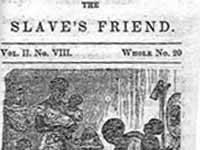
Anti-Slavery Publication for Children |
The American Anti-Slavery Society produced The Slave's Friend,
a monthly pamphlet of abolitionist poems, songs, and stories for
children. In its pages, young readers were encouraged to collect
money for the anti-slavery cause. Here a picture of the coffle-
yoke used to chain groups of slaves together illustrates a
dialogue about the horrors of slavery between a girl named Ellen
and her father, Mr. Murray. A shocked Ellen concludes that "I
will never boast of our liberty while there is a slave in this
land."
The Slave's Friend, Volume II, p. 3
New York: American Anti-Slavery Society, 1836
Rare Book and Special Collections Division (37)
|

Anti-Colonization Song |
Anti-colonization sentiment was common in abolitionist
publications such as The Anti-Slavery Picknick, a collection of
speeches, poems, dialogues, and songs intended for use in schools
and anti-slavery meetings. A song called the "Colored Man's
Opinion of Colonization" denounces plans to transport free blacks
out of the United States. Many African-Americans opposed
colonization, and, in 1831, a convention of free blacks meeting
in New York asserted, "This is our home, and this is our country.
Beneath its sod lie the bones of our fathers; for it some of them
fought, bled, and died. Here we were born, and here we will
die."
The Anti-Slavery Picknick, pp. 106-107
Boston: H.W. Williams, 1842
Rare Book and Special Collections Division (38)
|

Anti-Slavery Fair Advertisement
|
Although women were heavily involved in abolitionist activities,
opinion was divided as to their proper role. Some people
believed that women should serve in auxiliary roles that did not
expose them to competition with men. However, many women played
a highly visible role as writers and speakers for the cause.
Some of them gained activist experience that they later used in
support of women's rights. In this circular, the women of the
Massachusetts Anti-Slavery Society advertise a fundraising event
to support an agent. Well-known abolitionists such as Maria W.
Chapman, a spirited speaker, song writer, and editor of many
volumes of The Liberty Bell songbook, and Helen E. Garrison, wife
of William Lloyd Garrison, were involved in the event.
"Anti-Slavery Fair"
Boston: Massachusetts Anti-Slavery Society
Broadside
Rare Book and Special Collections Division (39)
|
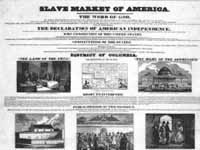
Slavery in the Washington, D.C., Area |
This broadside condemns the sale and keeping of slaves in the
District of Columbia. The work was issued during the 1835-1836
campaign to have Congress abolish slavery in the Capital. At the
top are contrasting scenes: a view of a reading of the
Declaration of Independence, captioned "The Land of the Free,"
with a scene of slaves being led past the Capitol, captioned "The
Home of the Oppressed." Also shown is the infamous Franklin &
Armfield Slave Prison, still standing on Duke Street in
Alexandria, Virginia. Opened in 1828, this center soon gained
control of nearly half the sea trade in slaves between Virginia
and Maryland and New Orleans. Most area slaves "sold South" were
held there before being shipped to a dreaded future on a rice,
cotton or indigo plantation.
"Slave Market of America"
New York: American Anti-Slavery Society, 1836
Broadside
Rare Book and Special Collections Division (40)
|
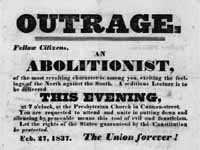
Anti-Abolitionist Handbill |
This handbill urging opponents of abolitionists to obstruct an
anti-slavery meeting demonstrates the depth of pro-slavery
feeling. Although the handbill advocates peaceful means, violence
sometimes erupted between the two factions. An emotion-laden
handbill was a factor in the well-known Boston riot of October
21, 1835. In that incident, a mob broke into the hall where the
Boston Female Anti-Slavery Society was meeting, and threatened
William Lloyd Garrison's life.
"Outrage," February 2, 1837
Handbill
Rare Book and Special Collections Division (41)
|

Anti-Slavery Almanac |
Each year the American Anti-Slavery Society distributed an
almanac containing poems, drawings, essays, and other
abolitionist material. This issue was compiled by Lydia Maria
Child (1802-1880), a popular writer recruited to the abolitionist
cause by William Lloyd Garrison. In 1833, Mrs. Child produced An
Appeal in Favor of that Class of Americans Called Africans, a
sensational anti-slavery publication that won converts to the
movement. From 1841 to 1849, she edited the New York-based
National Anti-Slavery Standard newspaper.
L[ydia] M[aria] Child, comp.
The Anti-Slavery Almanac for 1843, cover
New York:American Anti-Slavery Society, 1843
Rare Book and Special Collections Division (42)
|
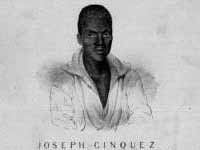
Slave-Revolt Leader Joseph Cinquez |
Joseph Cinquez (or Cinque) was one of a group of Africans from
Sierra Leone who had been kidnapped and sold into slavery. In
July 1839, Cinquez led a revolt on the slave ship Amistad, off
Cuba. The slaves took control of the ship and killed the crew,
but were soon captured and charged with piracy. Their subsequent
trials in New Haven, Connecticut, were causes celebres, pitting
abolitionists against President Martin Van Buren's
administration. In March 1841, the Supreme Court upheld the
lower court's decision to return Cinquez and his surviving
friends to Africa. John Quincy Adams had represented the
Africans before the Supreme Court, and they were set free largely
as a result of his eloquent pleading.
"Joseph Cinquez, the brave Congolese Chief, who prefers death to
Slavery, and who now lies in jail..."
James or Isaac Sheffield, Illustrator
New York: Moses Beach, 1839
Lithograph
Prints and Photographs Division (43)
|
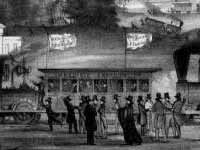
Abolitionist Song |
The illustration on this sheet-music cover is an allegory of the
triumph of abolitionism. A railroad car called "Immediate
Emancipation," is pulled by a locomotive named "Liberator."
These two names refer to William Lloyd Garrison, whose demand for
immediate emancipation was expressed in his newspaper The
Liberator. "Repealer," the second locomotive, probably refers to
the Irish insurgent movement, a cause with which many U.S.
abolitionists were allied. Flags bearing the names of two other
abolitionist publications, the Herald of Freedom and American
Standard (or National Anti-Slavery Standard) fly from the
"Emancipation" car. In the distance, two other trains, one
marked "Van," the other "Clay," crash, and their passengers flee.
These trains allude to Democrat and Whig presidential hopefuls
Martin Van Buren and Henry Clay.
"Get Off The Track: A Song for Emancipation...," cover
Jesse Hutchinson, Author
Boston, 1844
Sheet music
Prints and Photographs Division (44)
|
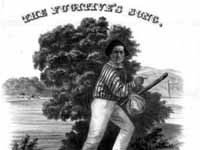
Abolitionist Sheet-Music |
Like many other reformers, abolitionists felt that good crusades
required singing. Hence, many abolitionists expressed themselves
in verse and songs. The cover of this sheet-music shows a
fictionalized and inaccurate version of the escape from slavery
of Frederick Douglass (1817-1895), who actually fled by ship.
The song is dedicated to Douglass "for his fearless advocacy,
signal ability, and wonderful success in behalf of His Brothers
in Bonds."
"The Fugitive's Song...,"cover
Boston: Henry Prentiss, 1845
Sheet-music
Prints and Photographs Division (45)
|

Abolitionist Appeal to Women |
Abolitionist materials aimed at women often appealed to their
sympathetic feeling as wives and mothers for the plight of slave
women who might be separated from their husbands or children.
"The Negro Woman's Appeal to Her White Sisters"
Richard Barrett, ca. 1850s
Broadside
Rare Book and Special Collections Division (46) |












![[Previous]](prev.gif)
![[Next]](next.gif)
 Library of Congress
Library of Congress